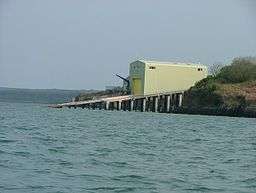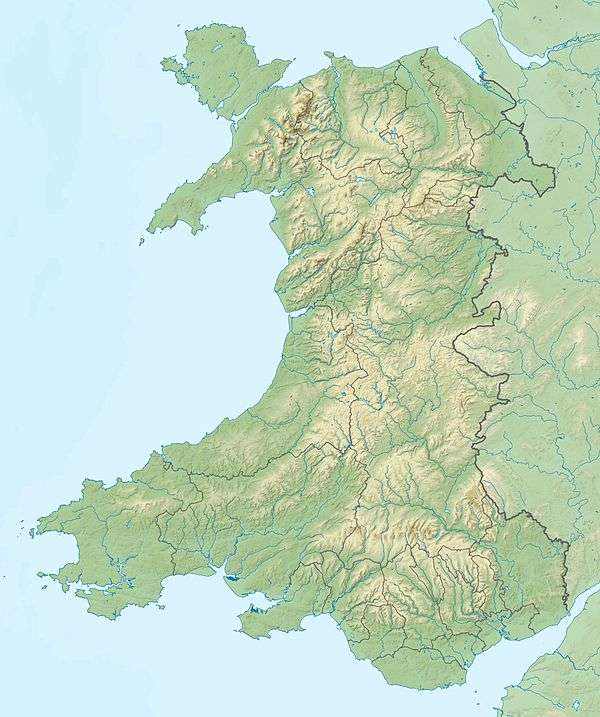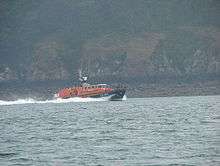Angle Lifeboat Station
| Angle Lifeboat Station | |
| RNLI Lifeboat station | |
 RNLI Lifeboat house, Angle | |
| Country | Wales, United Kingdom |
|---|---|
| Unitary authority | Pembrokeshire |
| Town | Angle |
| Location | Point Angle, Pembrokeshire, UK |
| - coordinates | 51°41′08″N 5°04′51″W / 51.68556°N 5.08083°WCoordinates: 51°41′08″N 5°04′51″W / 51.68556°N 5.08083°W |
| Founded | 1868 |
| Owner | Royal National Lifeboat Institution |
| Visitation | 9:00am–4:00pm Monday–Friday |
 Angle, Pembrokeshire | |
Angle Lifeboat Station, Angle, Pembrokeshire, Wales, first opened in 1868[1] after a letter from the local Coastguard requested a lifeboat station within the Milford Haven Waterway. Originally called Milford Lifeboat Station until 1892 when it was officially changed at a Royal National Lifeboat Institution committee meeting.[2]
The station currently operates a Tamar-class lifeboat Mark Mason and a D-class (IB1) lifeboat SuperG II.
History

The station was established by the RNLI in 1868, although three silver medals had already been awarded for rescues. A boat house and wooden slipway were built, the latter replaced by a stronger slipway in 1888. A new boathouse and roller slipway were built in 1927 and two years later the station took delivery of its first motor-lifeboat.
In 1991 construction began of a new, larger, boathouse and slipway adjacent to the 1927 structure. Following completion in 1992, the old boathouse and slipway were demolished.
In the 1990s an inshore lifeboat station was established and in 1996 a D-class lifeboat, D-493 Isabella Mary began service at the station. The 1992 all-weather lifeboat station was able to be adapted for the new, larger, Tamar class lifeboat and in 2009 the station took delivery of the Tamar-class, 16-11 Mark Mason.
Station honours

The first rescue in which the crew received medals was in the rescue of 27[1] (some say 33[3]) people who were on board the 1878-built Loch Shiel which had run into rocks off Thorn Island. Two lifeboat crew members and the honorary secretary received silver medals. One of the crew members was Thomas Rees. He is buried in the church yard at St Mary's. It was said that the lifeboat was unable to reach the crew of the Loch Shiel, but these brave people managed to get to them by climbing around Thorn island and getting a rope to the ship. They literally held on by their finger tips to achieve this.
The rescue is otherwise noteworthy as it is described as Wales' "Whisky Galore". The Loch Shiel was carrying goods from Scotland to Adelaide and included gunpowder, beer[4] and 7,500[5] (some say 7,000[3]) cases of Glasgow whisky. Much of this was never recovered. Some of the bottles are still amongst the wreck which are described as "undrinkable", but much of the cargo was only partially recovered by the customs men.[3] It was said that one local drank himself to death on the 100 proof whiskey.[4] In 1999, bottles of beer from the wreck were auctioned for £1000 per bottle.[5]
The next award was a bronze medal awarded to Coxswain James Watkins for rescuing 28 people on 26 November 1929 from the single-screw steamship Molesley which had been caught by a sudden wind change and a poor decision by its captain.[6] James Watkins went on to be awarded a silver medal for rescuing 6 people in 1944 from the motor boat Thor, and a year later another bronze medal for a difficult rescue of nine people from the steamer Walter L M Russ.[1] (This steamer had been seized from the Germans and sank on 15 July before it could be renamed the Empire Concourse.[7])
More recently, Coxswain William John Rees Holmes has been awarded two bronze medals. The first was in 1977 when the tanker Donna Marike was thought to be about to explode and the lifeboat stood by her in December 1976. The second bronze medal was for rescuing three people from the fishing boat Cairnsmore on 1 December 1978.[1]
In 1997 a third coxswain, Jeremy R. Rees, and his crew were awarded another bronze medal for rescuing four people after their motor boat, Dale Princess, was blown onto cliffs on Skomer Island. The rescue was made in gale force winds and stormy seas.[1]
Fleet
All Weather boats
Pulling and Sailing Lifeboats
| Dates in service | Class | ON | Name |
|---|---|---|---|
| 1868–1888 | 33' 10 oared Self-Righter | Katherine | |
| 1888–1906 | 37ft 12 oared Self-Righter | ON 223 | Henry Martin Harvey |
| 1906–1910 | 37ft 12 oared Self-Righter | Charlotte | |
| 1915–1919 | 35ft Self-Righter | ON 438 | James Stevens No. 11 |
| 1919–1927 | 38ft Watson | ON 434 | Henry Dundas |
| 1927–1929 | 40ft Watson | ON 462 | Thomas Fielden |
Steam lifeboat
| Dates in service | Class | ON | Name | Comments |
|---|---|---|---|---|
| 1908–1915 | 56ft 6in Steam-class | ON 420 | James Stevens No. 3 | Ex-Gorleston, Grimsby |
Motor Lifeboats
| Dates in service | Class | ON | Op. No. | Name | Comments |
|---|---|---|---|---|---|
| 1929–1957 | 45ft 6in Watson-class | ON 713 | Elizabeth Elson | ||
| 1957–1987 | 46ft 9in Watson-class | ON 931 | Richard Vernon & Mary Garforth of Leeds | ||
| 1987–2008 | Tyne-class | ON 1114 | 47-011 | The Lady Rank | |
| 2008–2009 | Tyne-class | ON 1112 | 47-010 | RFA Sir Galahad | Ex-Tenby |
| 2009–present | Tamar-class | ON 1291 | 16-11 | Mark Mason |
Inshore Lifeboats
| Dates in service | Class | Op. No. | Name | Comments |
|---|---|---|---|---|
| 1994–1996 | D-class (EA16) | D-336 | Temporary assignment from the relief fleet, | |
| 1996–2004 | D-class (EA16) | D-493 | Isabella Mary | |
| 2004–2015 | D-class (IB1) | D-638 | Richard John Talbot Hillier | |
| 2015–present | D-class (IB1) | D-776 | SuperG II |
See also
References
- 1 2 3 4 5 "Angle Lifeboat Station (RNLI website)". Retrieved 4 May 2015.
- ↑ Angle Station History Archived 20 August 2010 at the Wayback Machine.
- 1 2 3 letters, wrecksite.eu, accessed 30 August 2008
- 1 2 Loch Shiel, Pembrokeshire wrecks
- 1 2 Diver sinks £1,000 pint, BBC, accessed 30 August 2008
- ↑ Wreck report for Molesley, 19 August 1930, GB Board of Trade
- ↑ EMPIRE - C, mariners-l.co.uk